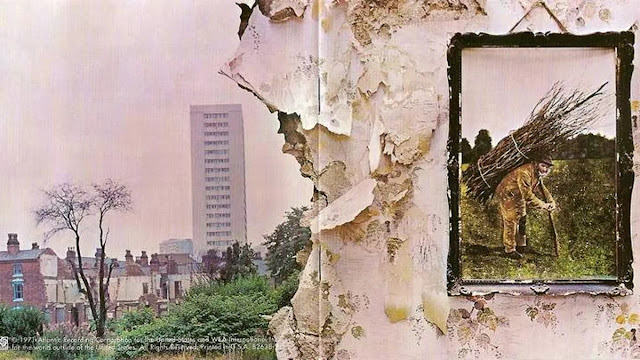For decades fans have speculated who the mysterious old man carrying sticks on the cover of Led Zeppelin’s fourth album might be. A West Country historian has finally uncovered the truth. The original of the photograph made famous by the band was recently discovered in a late Victorian photograph album. The discovery was made by Brian Edwards, a Visiting Research Fellow with the Regional History Centre at the University of the West of England, and is in the Museum collections.
Released on November 8, 1971, Led Zeppelin IV has sold more than 37 million copies worldwide. The album’s cover artwork was radically absent of any indication of the musicians or a title. The framed image, often been referred to as a painting, is understood to have been discovered by the band’s lead singer Robert Plant in an antique shop near guitarist Jimmy Page’s house in Pangbourne, Berkshire. Closer inspection reveals this framed image was a colored photograph, the whereabouts of which is now unknown.
“I used to spend a lot of time going to junk shops looking for things that other people might have missed,” Page said at the time. “Robert was on a search with me one time, and we went to this place in Reading where things were just piled up on one another. Robert found the picture of the old man with the sticks and suggested that we work it into our cover somehow. So we decided to contrast the modern skyscraper on the back with the old man with the sticks – you see the destruction of the old, and the new coming forward.”
 |
| Cover for the album Led Zeppelin IV by Led Zeppelin. |
The black and white original Victorian photograph was discovered during ongoing research extending from the Ways of Seeing Wiltshire exhibition (May 20, 2021 to August 30, 2021), which was curated by Brian Edwards in partnership with Wiltshire Museum. From paintings to photographs and artefacts to memories, Edwards’ research involved monitoring everyday sources that stimulates public engagement with Wiltshire’s past. While following up on some early photographs of Stonehenge, Edwards came across the Victorian photograph Led Zeppelin made familiar over half a century ago.
Featuring exceptional photographs from Wiltshire, Dorset and Somerset, the Victorian photograph album contained over 100 architectural views and street scenes together with a few portraits of rural workers. Most of the photographs are titled and beneath the photograph made famous by Led Zeppelin the photographer has written ‘A Wiltshire Thatcher.’ The Victorian photograph album is titled ‘Reminiscences of a visit to Shaftesbury. Whitsuntide 1892. A present to Auntie from Ernest.’
Brian Edwards said: “Led Zeppelin created the soundtrack that has accompanied me since my teenage years, so I really hope the discovery of this Victorian photograph pleases and entertains Robert, Jimmy, and John Paul.”
 |
| Gatefold cover of Led Zeppelin IV by Led Zeppelin. |
“The first thing you notice is that as a photograph, it’s a really, really good photograph and also that the area of the tour being documented was quite a tight area geographically,” Edwards explained. “We had those clues, plus the name Ernest and as a bit of a stroke of luck I happened to remember that a lot of early photographers were also chemists. I only knew of one chemist in Wiltshire operating in the mid-century called Farmer, so I looked him up and he left Wilshire to start up a photography business in Brighton. He had three sons, one of whom was called Ernest. This Ernest not only went on to become a photographer but also a teacher of photography and became quite well known. Fortunately, I found his marriage certificate online and there were handwriting matches with the words in the photo album.”
A part signature matching the writing in the album suggests the photographer is Ernest Howard Farmer (1856–1944), the first head of the School of Photography at the then newly renamed Polytechnic Regent Street. Now part of the University of Westminster, Farmer had worked in the same building as the instructor of photography since 1882, when it was then known as the Polytechnic Young Men’s Christian Institute.
Further research suggests the thatcher captured in the image is Lot Long (sometimes Longyear), who was born in Mere in 1823 and died in 1893. At the time the photograph was taken, Lot was a widower living in a small cottage in Shaftesbury Road, Mere.
 |
| Lot Long, a Wiltshire thatcher in a 1892 photograph by Ernest Howard Farmer. |
“I had a similar bit of luck with the character in the photograph,” Edwards continued. “There were only around 30 or 40 thatchers working in Wilshire in the 1890s and I could rule a lot of them out as they would have been in the north of the county or their age ruled them out, which only left me with three. Once I’d whittled them down, there was only one at that time in that specific area which was Lot Long. So, we think our friend on the cover of Led Zeppelin IV is Lot Long from Mere in Wiltshire.”
(via Wiltshire Museum)









Long live Lot Long former mystery man now has a name. ☺️
ReplyDelete